This section is intended to provide the steps necessary to successfully provision a user in Office 365.
The Migrator for Notes application provides for the automatic creation of Office 365 Exchange Online mail-enabled users from HCL Notes. This process is completed through the application of an Office 365 license that has the Exchange Online option to the accounts.
|
|
|
|
|
|
After a user’s Exchange account has been created, there are several steps necessary to ensure proper mail delivery between the two email systems. The Migrator for Notes database properly sets the user's HCL Notes person document to direct mail to the user's new Exchange mailbox as well as setting access control rights on the user's HCL Notes mail file, if required.
This section is intended to provide the steps necessary to successfully provision a user in Office 365.
The Migrator for Notes application provides for the automatic creation of Office 365 Exchange Online mail-enabled users from HCL Notes. This process is completed through the application of an Office 365 license that has the Exchange Online option to the accounts.
|
|
|
|
|
|
After a user’s Exchange account has been created, there are several steps necessary to ensure proper mail delivery between the two email systems. The Migrator for Notes database properly sets the user's HCL Notes person document to direct mail to the user's new Exchange mailbox as well as setting access control rights on the user's HCL Notes mail file, if required.
Expanding the Provisioning view displays the following subfolders:
Enable Mailboxes
Post-Enablement Tools
Match Domino/AD Usernames
Advanced

Provisioning View
Perform the following steps to set up the Exchange mailbox databases:
Select the Enable Mailboxes view to begin enabling mailboxes
Select one or more entries and then click the Set Country Code button to select a country code:

Once the Country Code is set, select one or more entries and then click the Enable/ Activate Mailbox button to enable a Mailbox; enter your password in the Begin Activation of Office 365 Users command line window:


Before end user mail file migration takes place, be sure that the Notes users have matching accounts in Office 365 (in Validation). This process helps in checking if the username that is being migrated has an existing account in the new Office 365 environment. However, matching usernames is not required if you are migrating to a .pst file.
Next, select one or more entries and then click the Set Full Access button and select Set Full Access:
Click Yes in the Validate Users In Office 365 dialog box that appears and then enter your password in the Windows PowerShell credential request window
The Full Access Status column will be populated to apply the Settings | Office365 | Office 365 Security Group to the Full Access Delegation on the users’ Office 365 Mailboxes that the Notes data will be migrated to.
|
|
|
Expand the Match Domino/AD Usernames folder in the Navigation Pane
Click on Match Usernames

Match Usernames View
The Data Pane displays a list of users that are unresolved or unmatched with their AD accounts. Click the Match Domino Usernames to Exchange Usernames button and select either Match Selected users using PowerShell or Match all users using PowerShell. PowerShell is the only method that is supported for Office 365.

|
|
|
|
|
|
|
|
|

The following table describes the function of each menu option:
|
Option |
Description |
|
Match Users |
Matches all the users using LDAP |
|
Match Selected Users |
Matches selected users using LDAP |
|
Match Unresolved Users |
Matches only the unresolved users in the view |
|
Match Selected users on CAS server |
Matches the selected users on the Exchange CAS server |
|
Match Selected users using PowerShell |
Matches the selected users using PowerShell |
|
Match all users using PowerShell |
Matches all users using PowerShell |
Click the Change Step To… button to select a migration step:
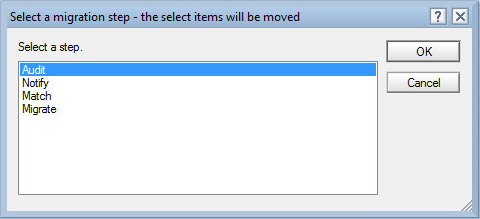
Click on the Check Errors folder in the Navigation Pane to check errors:

|
|
If you cannot resolve the errors or need assistance determining why an error occurred, contact Product Support. |
Click on the Advanced | User Migration Actions button to access additional functions:

The following table describes the function of each menu option; these are the same options available in the User Migration Actions dropdown menu from the Preparation | Advanced view:
|
Option |
Description |
|
Send Migration Message to Selected User(s) |
Allows you to send an email notification using predefined or customized message templates to selected users. |
|
Insert Migration Message into Selected User(s) Inbox |
Allows you to simply insert a migration message into a user’s inbox. The Insert Migration Message option is used when mail cannot be delivered to the user's Notes inbox. This option is also used if the user has already been migrated and their mail is now being delivered to Outlook, but post-migration, they need to sync contacts or to copy archives that were missed before the migration. In these cases, messages are delivered to Outlook rather than Notes, but don’t work. Running this agent drops the selected migration messages directly into the Notes inbox rather than mailing it. |
|
Send Rules Email to Selected User(s) |
Allows you to send Rules Email to Selected Users. |
|
Send Encrypted Summary Email to Selected User(s) |
Allows you to send a summary of all the encrypted items in an email to selected users. |
|
Fix Contacts & Group Members |
Allows you to look for personal contacts whose mail address format is NOT SMTP (usually imported from the Domino Directory). It will search the Domino Directory for a matching Person document, and if found, replace the mail address with the internet address from Domino. Likewise, it will convert personal group members from Notes Name format to SMTP for members that can be matched in the Domino Directory.
Double-byte characters of Display Names are not processed correctly when converting to the Notes Canonical Name if Fix Contacts & Group Members has not been run prior to migration. |
|
Fix Folders |
Allows you to fix folders appending a “-Migrated” to the end of any non-system created folder that has a reserved system name (ex: Inbox, Drafts, etc). While Lotus Notes will allow these folders to be created, Exchange will not. Refer to the Installation and Configuration Guide for information on the settings that control this feature. |
|
Fix Chat |
Allows you to fix HTML formatting in Sametime Chat transcripts stored in the user’s mail file. This will perform a search of the mail file for Sametime Chat documents and will then edit and save the document in the Notes user interface.
Note: This does not need to be run if the user does not save Sametime Chat transcripts, the Settings are configured for Rich Text, or if the chat documents are migrating with correct HTML formatting. |
|
Maintain Transitional Calendar Workflow |
Allows you to populate BTCache.nsf recurrence pattern information for repeat meetings to ensure that calendar workflow functions as intended regardless of the migration status of the chairperson and invitees. This assumes that Notes Integration is fully configured. When this option is run, the number of errors, start and completion status, and messages that could not be found in the destination database are listed in the MTCW Error Report section of the person document. |
The Post-Enablement Tools view under Provisioning will retain all accounts until these are Marked Complete after the migration is completed. This allows you to update mail routing in the event of a failure that cannot be recovered and to set the account back to Notes.
Expand the Provisioning | Post-Enablement Tools view to update routing to the Exchange account and other post migration actions
Click the Routing Update Actions| Set Mail Routing back to Notes option to roll back to Notes if needed:

Select the Mark Complete button to mark actions as complete.

|
|
|
A Name Translation Table contains email addresses of Notes users and their corresponding SMTP and/or Exchange legacy Distinguished Name (legacyExchangeDN). The translation information contained in the table is used by the Migrator for Notes migration engine to look up every entry in the Domino Directory and convert it to an SMTP style address or Exchange legacyDN. Every email address found in every mail message, calendar entry, contact, or task being migrated is translated to its corresponding SMTP address (Internet address) and/or Exchange legacyDN (if available). This is required for migrated items in Exchange to have the correct email address format so that users can reply to the emails or calendar items in Outlook using the Exchange email address format.
This is required for migrated items in Office 365 to have the correct email address format so that users can reply to the emails or calendar items in Outlook using the Exchange email address format.
For migrations to Exchange mailboxes, the legacyExchangeDN is recommended and does require matching of the entries in the Name Translation table to the mail-enabled user or mailbox-enabled user accounts. For PST only archive migrations where there will not be any data uploaded into Exchange mailboxes, the legacyExchangeDN is not required and the SMTP address can be used for the translation of Notes addresses.
|
|
|
Migrator for Notes will use the Notes Common Name for the translated Display Name. This applies to recipients on migrated messages with the SMTP or legacyExchangeDN applied for the mail routing address in Exchange mailboxes.
Migrator for Notes allows you to enable free/busy information in Outlook after migration because the users in the Name Translation Table are resolved to the legacyExchangeDN instead of the SMTP address. This allows Outlook to utilize the native free/busy functionality on migrated documents.
The name resolution process is used to apply the Exchange legacyDN during the migration of messages to Notes formatted recipients. This results in migrated entries resolving to the user mailbox in Exchange, therefore making correctly-populated free/busy information available after migration.
A typical Exchange legacyDN follows the pattern displayed below:
/o=DomainName/ou=Exchange Administrative Group (FYDIBOHF23SPDLT)/cn=Recipients/cn=LegacyName
Following is an example of a properly resolved Name Translation document:
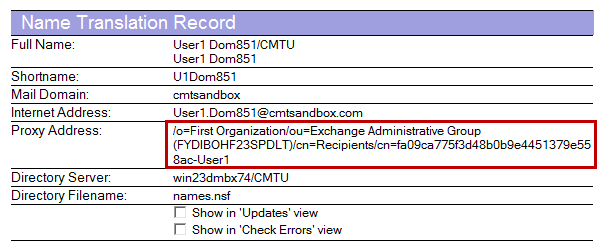
Names Translation Document
To create the Name Translation Table from the Domino directory, expand Email Repliability in the Navigation Pane
Click the Add Names to Translation Table | Add Names to the Translation Table button:
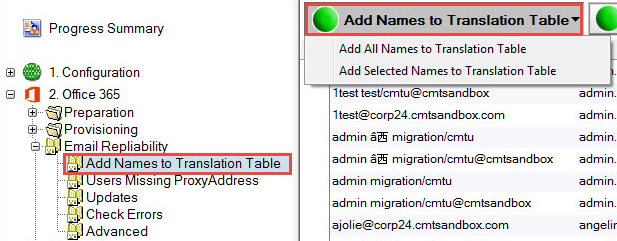
Add Names to Translation Table Button
The following table describes each setting in the drop-down menu:
|
Settings |
Description |
|
Add All Names to Translation Table |
Adds all the names in the Domino directory to the Translation Table |
|
Add Selected Names to Translation Table |
Adds only the selected names from the Domino directory to the Translation Table |
|
|
Adding all Domino users’ names to the Translation Table is the recommended method of populating the Name Translation Table. The Translation Table should contain every email address for every user that may have sent an email to any other user. Please note, this is not a list of users to be migrated. It is a list used to translate addresses in migrated messages, calendars, and other migrated documents, so it needs to be as exhaustive as possible. |
|
|
It is recommended to perform regular updates to the Translation Table as new users may be added to the Domino Directory throughout the migration process. |
Click Add All Names to Translation Table
If more than one Domino directory has been defined, select a directory from the list and click OK:
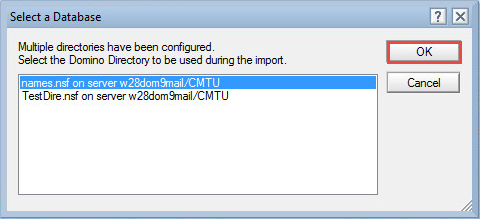
A confirmation box appears. Click Yes to confirm that all entries will be added to the Name Translation Table:
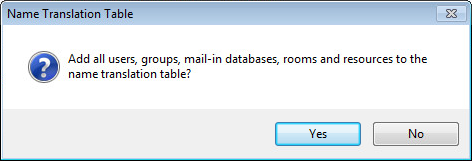
After you have selected the entries to add, depending on the number of name entries, this process could take from a few seconds to several minutes; after it’s completed, a confirmation box appears stating that all users have been added to the Translation Table
Click OK
The Data Pane displays that all the names with a Person document found in the Domino directory have been added to the Name Translation Table
Notice that each user has multiple entries; these are all the possible addresses that the user is using and a corresponding SMTP address for each of these addresses is provided in the Name Translation Table:
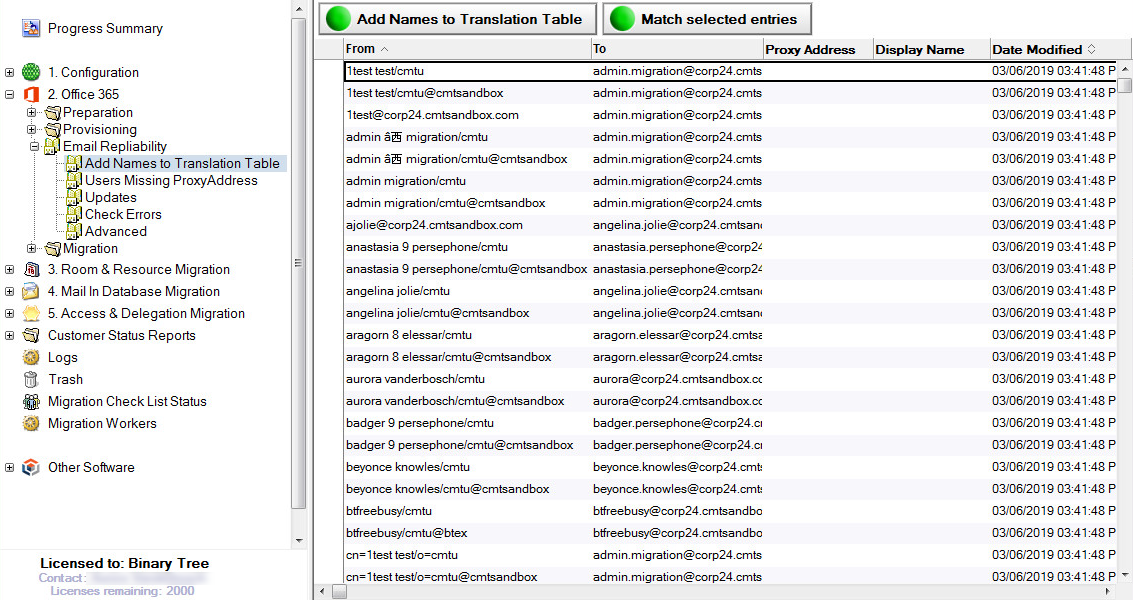
Add Names to Translation Table View
Click Add Selected Names to Translation Table.
If more than one Domino directory has been defined, the selection dialog box appears with a drop-down list of Domino directories. Select a Domino Directory from the drop-down list, click the type of records to add, and then click Finish:
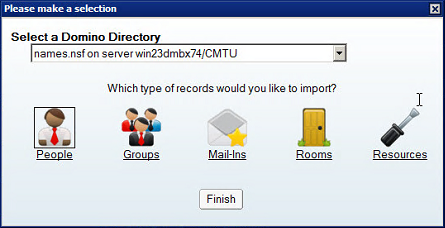
If a single Domino directory has been defined, the selection dialog box without a drop-down list of Domino directories appears; click the type of records to add and click Finish:
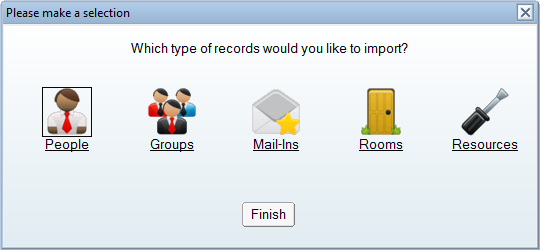
The correct view for the record type selected appears; select the intended records and click OK:
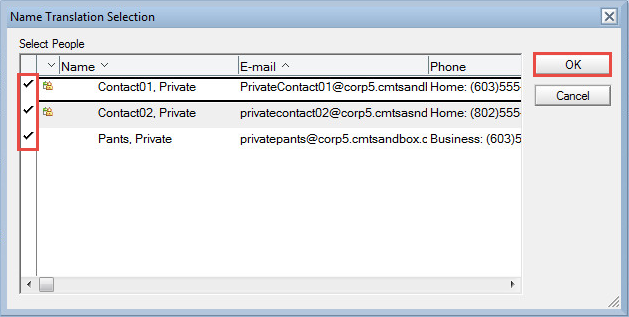
Name Translation Selection Dialog Box
A confirmation box appears stating that the selected records have been added to the Translation Table; click OK
|
|
|
After the Domino objects are added to the translation table from the Domino directory, you need to resolve these Domino entries to their Exchange entries.
There are several method options for matching entries; click the Match selected entries button:

The following table describes each drop-down menu option:
|
Settings |
Description |
|
Match Selected entries using PowerShell |
Uses PowerShell to resolve selected Domino users listed in the view to Exchange |
|
Match all entries using PowerShell |
Uses PowerShell to resolve all Domino users listed in the view to Exchange |
|
|
PowerShell is required if you are migrating to Office365. The Display Name column in the translation table view within the Migrator for Notes database is a static representation of the displayName attribute in Active Directory and is for reference only. It will not reflect any changes made to the displayName attribute after the translation table has been built. If the PowerShell authentication account is entered and Modern Authentication is enabled for PowerShell processing (Settings | Additional) the matching will use the Email Repliability bulk processing. This will split the matching into the batch size specified and create new PowerShell sessions for each batch. |
Select one or more entries in the Data Pane
Click the Match selected entries using PowerShell or Match all entries using PowerShell drop-down menu option
The Powershell User Match confirmation box appears; click Yes:
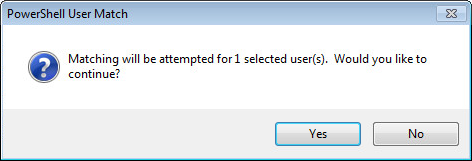
Enter the requested password in the dialog box:
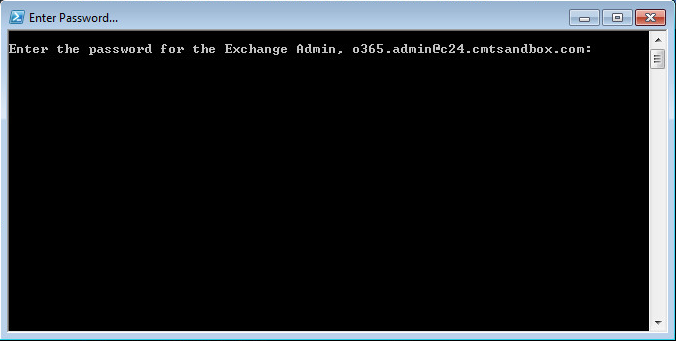
The matching completes; click OK:
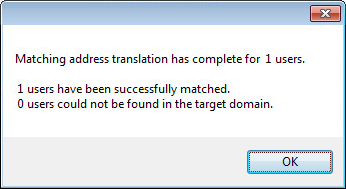
Once the Translation Table is created, you can update it whenever there are new entries added or removed from the Domino directory or user accounts are renamed in the Domino Directory.
To update the Translation table, click Updates | Update Name Translation from Domino Directory:
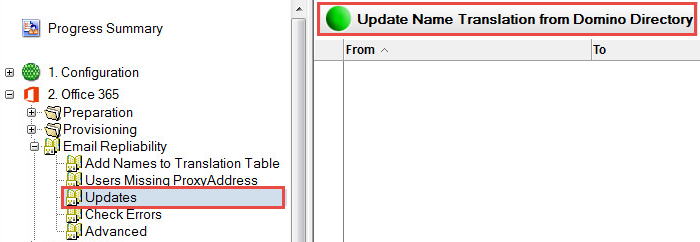
Updates View
|
|
|
Items that could not be imported will be displayed in the Check Errors view.
To view translation errors, click Check Errors in the Navigation Pane:

Check Errors View
|
|
It is recommended to check accounts in Domino and verify the corresponding entries in Active Directory. All items to be translated require an Internet Address (SMTP) in Domino, but some items, like Domino system groups, will not be expected to have these and can be safely ignored. If you cannot resolve the error or need assistance determining why an error occurred, contact Product Support. |